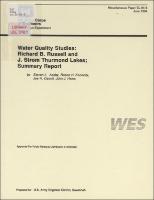Please use this identifier to cite or link to this item:
https://hdl.handle.net/11681/20504| Title: | Water quality studies : Richard B. Russell and J. Strom Thurmond Lakes; summary report |
| Authors: | Ashby, Steven L. Kennedy, Robert H. Carroll, Joe H. Hains, John J. |
| Keywords: | J. Strom Thurmond Lake (Ga. and S.C.) Hartwell Lake (S.C. and Ga.) Richard B. Russell Lake (Ga. and S.C.) Savannah River (Ga. and S.C.) Reservoirs Water quality Limnology Oxygenation |
| Publisher: | Environmental Laboratory (U.S.) |
| Series/Report no.: | Miscellaneous Paper;EL-94-6 |
| Abstract: | Abstract: This report is the fifth in a series of annual interim reports documenting the results of a comprehensive water quality study at Hartwell and Richard B. Russell Lakes and at J. Strom Thurmond Dam and Reservoir (formerly called Clarks Hill Dam and Lake) in the Savannah River Basin and pertains to the period January to December 1988. This report also summarizes the results of all studies during the 5-year period following impoundment of Richard B. Russell Lake. Water quality conditions in Richard B. Russell Lake were markedly improved in 1988 compared with those of early study years. Most pronounced was a marked decline in the extent of the anoxic region in the main stem of the lake. Coincidentally, concentrations of manganese and iron in the main stem of the lake and in release waters were lower than concentrations observed in previous years. Conditions in the major tributary embayments were similar to those of previous years, however. Continued improvement in water quality is anticipated over the next several years, due to continued reduction in the decomposition of organic material inundated during impoundment. Dissolved oxygen concentrations in Richard B. Russell Lake releases during summer months were maintained near 6 mg/ℓ with operation of the oxygenation system. Water quality in J. Strom Thurmond Lake was similar to previous study years; however, spatial trends in temperature and dissolved oxygen concentrations were observed. Cooler hypolimnetic temperatures and a more pronounced thermocline suggest that the thermal structure in the lake is more defined than that observed prior to impoundment of Richard B. Russell Lake. Hypolimnetic dissolved oxygen concentrations have increased in the mid- and upstream regions of J. Strom Thurmond Lake, but concentrations in the hypolimnion of the downstream region of the lake have declined since 1984. Manganese and iron continue to be the most pronounced of chemical parameters currently monitored. Transport of dissolved manganese and particulate iron in the three-lake system is apparent, but the implications of effects on water quality are less discernible. |
| URI: | http://hdl.handle.net/11681/20504 |
| Appears in Collections: | Miscellaneous Paper |
Files in This Item:
| File | Description | Size | Format | |
|---|---|---|---|---|
| MP EL-94-6.pdf | 12.48 MB | Adobe PDF |  View/Open |